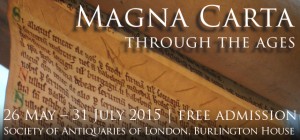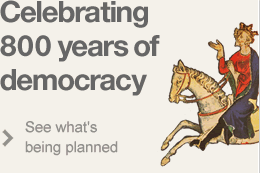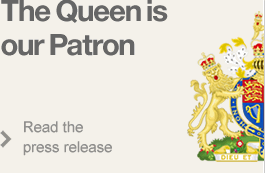
26 May – 31 July | Free Exhibition
Society of Antiquaries of London, Burlington House, Piccadilly, London
As part of the celebrations to mark the 800th anniversary of Magna Carta, the Society of Antiquaries staged a special exhibition where visitors had the unique opportunity to see its three copies of the Great Charter. The exhibition was on display from 26 May to 30 July 2015 at the Society’s premises in Burlington House, London.
The exhibition explored the antiquarian interest in the charter through the centuries and the Society’s three copies showed the ways in which Magna Carta has continued to be relevant to successive generations.
Find out more at www.sal.org.uk/magna-carta
The copies:
- A version of the 1215 Magna Carta found in a 13th century cartulary of Peterborough Abbey known as the Black Book of Peterborough (SAL ref: MS60). It contains distinct differences from the authorised version, preserving elements of drafts made at Runnymede, and thus provides an important witness to the processes by which the terms of Magna Carta were negotiated in the weeks between late May and mid-June 1215.
- A unique copy of the 1225 reissue of Magna Carta probably made at Halesowen Abbey (SAL ref: MS544). This is a revision issued by Henry III, which represents the final form as later confirmed and enshrined in English law, with 47 clauses instead of the original 63. Since then it has been regarded as the chief constitutional defence against arbitrary rule. It is an important testimony to the fact that one monastic community at least thought Magna Carta of sufficient importance to warrant the production of an expensive and visually impressive document.
- An early 14th century collection of Statutes of the Realm (SAL ref: MS701), including a copy of the 1225 reissue of Magna Carta and the 1225 Charter of the Forest (Magna Carta’s companion document since the second re-issue of 1217). It is an illuminated document for a high status individual (probably a practising lawyer) and it is unusual for the fact that it has a transcript of both charters. It is therefore an important witness to the use of Magna Carta and the Charter of Forests in an early 14th century legal context.
The exhibition and programme, linking these stories together, explored Magna Carta as the creation of people who could not imagine a kingdom without a king, but who were driven to the point of rebellion because of a king’s misrule. It also examined how the Charter was re-issued and re-interpreted through the 13th and 14th centuries and the part that antiquaries have played in the process of reinterpreting the charters significance from the 17th to 20th centuries.
Acknowledgements
This exhibition was made possible by the generous support of Bank of America Merrill Lynch, the Headley Trust, Heritage Lottery Fund, Magna Carta 800th Anniversary Committee and the Ruddock Foundation for the Arts.
Featured Article
The early settlers in the United States took with them copies of the Magna Carta. One undertaking given by King John in that Charter was as follows: No freeman shall be arrested or imprisoned or disseised or outlawed or exiled or in...
Read on...Recent Articles
- Magna Carta's American Adventure
- 800th anniversary of Bristol...
- Bristol 800 concert and...
- Emancipation and Magna Carta
- Terrorism and Tolerance -...
- Magna Carta
- Magna Carta Benches mark...
- ABA Magna Carta Memorial...
Stay updated
If you would like to keep informed about the work of the Magna Carta Trust and our partners, please sign up to the newsletter below.
Become a Supporter
There are a number of significant supporter opportunities. Register your interest early to ensure the widest range of options.
Find out more




